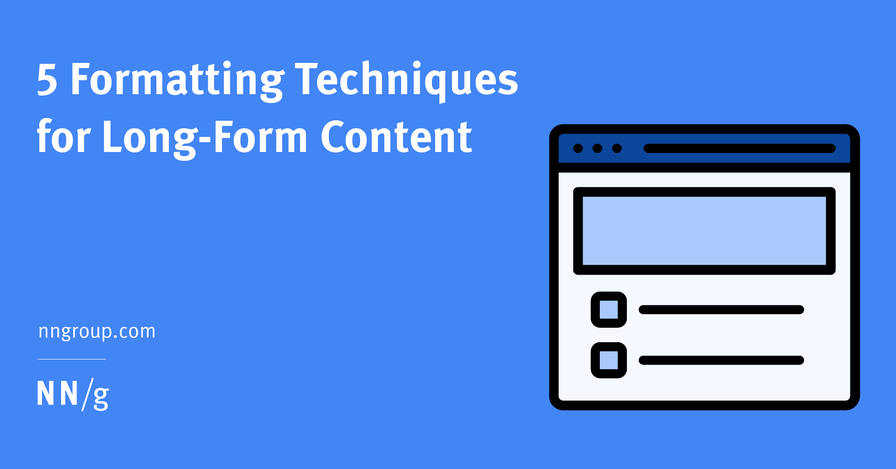5 Formatting Techniques for Long-Form Content

my notes ( ? )
Thoughtful Planning and Editing Comes First
Delivering valuable content starts with understanding who will consume it and what their goals are. Content developed without thoughtful consideration is often unnecessarily long. When planning new content, think about what people are looking for.
Before jumping into formatting, assess your content to see if it can be refined, reduced, or rewritten. Users appreciate brevity and plain language, hence avoid long-winded sentences to sound sophisticated. Paring down unnecessary details decreases page length and makes your content more compelling.
As you start to edit your content, the following questions can guide you:
- Is the content essential?
- Does the content have a proper level of granularity?
- Can the content be condensed?
- Can the content be rephrased to be more simple or clear?
Basic Structuring Strategies
Formatting and structuring go hand in hand in content planning. While formatting ensures that content is predictable and easy to scan, structuring involves defining an organizational strategy to deliver the content effectively. Strategically structure your content before applying formatting to make sure that it is logical and coherent.
A good content structure helps users form a mental model of the page and navigate it efficiently. The following are some common strategies for structuring content:
- Provide a helpful overview: Allow users to get a sense of the page offering without delving into details by providing them with a table of contents for the page.
- Create content chunks: Break down the content body into digestible sections to support scanning.
- Layer content and disclose information progressively: Allow users to access the first level of the content and disclose the rest upon request (for instance, by using accordions).
- Offer direct access to specific sections: Use in-page links to allow users to skip irrelevant sections and jump to the content of interest.
Five Content-Formatting Techniques
Formatting comes into play after a clear content structure is defined. Our research indicates that the following formatting techniques help users to efficiently navigate and consume long-form content.
- summary
- call-outs
- bullet points
- helpful visuals
- bolding and highlight keypoints
Conclusion
Reading is the primary action people perform online, but people strive to read as little as possible. They rely on scanning instead. Scanning must be supported through thoughtful editing, strategic structuring, and effective formatting of long-form content. Use the 5 formatting tactics discussed in this article—summaries, bold and highlight, bullet points, callouts, and visuals—to break down your content and create a dynamic and engaging reading experience.
Read the Full Post
The above notes were curated from the full post www.nngroup.com/articles/formatting-long-form-content/.Related reading
More Stuff I Do
More Stuff tagged content design , writing for digital , web writing
See also: Content creation & management , Writing content